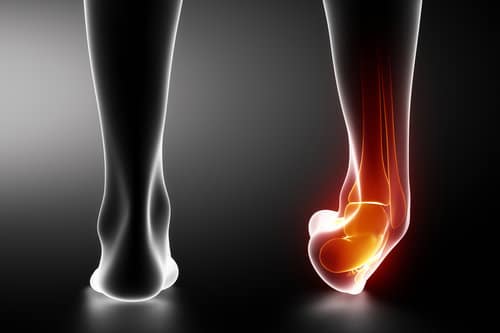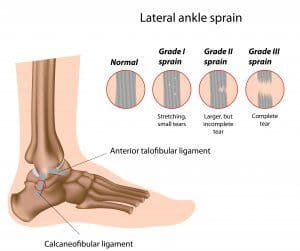
What exactly is a sprained ankle?
An ankle sprain happens when the ligaments holding the joint together are torn or stretched out. It’s an extremely common sports injury and can be quite painful.
Ankle sprain signs and symptoms:
- Immediate pain and swelling.
- Difficulty moving the ankle.
- Pain when putting weight on the ankle.
How will I know if I’ve sprained my ankle?
The following is a list of the most common signs and symptoms of an ankle sprain. You may have sprained your ankle if:
- You have immediate swelling. This is often severe.
- The ankle joint is tender to the touch.
- Bruising is present. This can be extensive.
- Pain can be sudden and severe, especially with a Grade II or Grade III sprain.
- The ankle won’t be able to bear weight without significant pain.
- The ankle joint will feel stiff in the following days.
- A wobbly or unstable feeling in the ankle while standing.
Recap:
Grade I sprains are overstretched but not torn ligaments. There is pain and swelling but no loss of stability. Grade II sprains are partial tears, and the joint often loses stability and feels “wobbly.” Grade III sprains involve full-thickness tears and the joint can become severely unstable.
What kind of rehab exercises should be done?
In almost all cases rehab exercises should begin the day of the injury. These can begin with simple, non-weight bearing range of motion exercises. One of the most common is ankle “ABCs.” With the ankle elevated, simply trace the alphabet in the air. Keep the motions small, and never push your ankle past the point of mild discomfort. This will keep the ankle moving, increase circulation, and aid in healing.
After the acute phase of the injury, strengthening and stretching exercises should be performed. The “ankle walk” drills are commonly used. The patient walks forward for small distances while standing on the tip-toes, the outside and inside of the foot, and the heels. The same is then done when walking backwards. This challenges and strengthens all of the muscles which control the ankle. It also helps develop coordination which is necessary to avoid future sprains.
How long does it take for a sprained ankle to heal?
The length of time it takes to recover from a sprained ankle depends on how bad the damage was. A small sprain might take two weeks to recover, whereas a major sprain might take six to twelve weeks.
What can sprain an ankle?
When the foot suddenly flips or twists, pulling the ankle joint out of its natural position, an ankle sprain frequently results. The ankle may rotate inward during physical activity as a result of a quick or unexpected action. One or more ankle ligaments become strained or torn as a result of this.
These tears can result in some edema or bruising. When you put weight on the afflicted location, you could experience pain or discomfort as well. The sprain could also harm blood vessels, tendon, and cartilage.
Anyone, regardless of age, can sustain an ankle sprain. This kind of injury can be brought on by playing sports, walking on uneven ground, or even wearing the wrong shoes.
Symptoms of an ankle sprain
The following signs and symptoms could be brought on by the inflammation that follows an ankle sprain:
- Bruising and swelling. It can be so swollen that if you press with your finger, it will leave an indentation.
- Pain. After a sprain, your nerves are more sensitive. The joint aches and could even throb. When you press on it, move your foot in specific ways, walk, or stand up, it frequently gets worse.
- Warmth and redness. A sprain increases blood flow to the injured area.
- Instability. When the ligament is completely torn, the joint may feel feeble.
- Difficulty walking. You may have limited ankle mobility if you have a sprain.
Can Sprained Ankle Lead To Long-Term Problems?
Yes, sprained ankle may seem like a normal injury but if it manages to progress, it can lead to long-term problems if not treated properly. You can experience chronic instability, persistent pain, weakness, swelling and difficulty in walking, especially if the ligament hasn’t healed correctly. If you experienced repeated sprains then it can highly increase the risk of arthritis and joint damage overtime, which is something really concerning. Other issues like scar tissue formation and improper rehabilitation also limits mobility and flexibility. The best you can do to prevent all of this is strengthening exercises, physical therapy, and using good footwear to help prevent long-term issues. However, even after this your symptoms persist, you should talk to a doctor, untreated sprains are never great so getting the right medical treatment should be the first step.
Can I Walk With A Sprained Ankle?
Whether you can or should walk sprained ankle depends severity of the injury. If your sprain is still mild, you can still walk though you can experience minimal pain, therefore rest is still recommend at this stage. On a moderate to severe sprain, pain will be significant, you will experience swelling, instability and walking will be difficult, which can worsen the injury even more. However, if your condition is really serious, it’s obvious you shouldn’t try to walk at all, try to follow the R.I.C.E method in all stages, and use crutches Or braces if needed. Make sure you don’t put ant weight on ankle until the pain decreases, and if swelling doesn’t go away you must visit a doctor, who knows there’s a fracture inside?
Are There Surgical Options For Severe Ankle Sprain?
Yes, if there’s a significant ligament damage, chronic instability, or conservative treatments don’t work, then procedures like ligament repair, or ligament reconstruction may be used.
When to contact a doctor
A sprain most likely won’t require you to visit the doctor. But contact them if:
Your pain is severe or not alleviated by using cold, elevation, and over-the-counter drugs.
We can help you. Call 878-313-3338 for an appointment.

